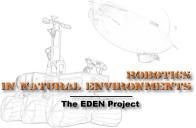
A key issue for mobile machines autonomy
The ability for the rover to localize itself while it navigates,
i.e. to estimate its position and the precision on this position,
is essential for various reasons:
- The missions to be achieved by the rover are often expressed in localization terms, explicitly (e.g. ``reach that position'', ``explore this area''...) or more implicitly (such as in ``return near the lander'' when it is out of sight).
- Long range navigation calls for the building of global maps of the environment, to find trajectories or paths and to enable mission supervision. The spatial consistency of such maps is required to allow an efficient and robust behavior of the rover: it is the knowledge of the rover position that guarantees this consistency.
- Finally, the proper execution of the geometric trajectories provided by the path planners calls for the precise knowledge of the rover motions.
Robot self-localization is therefore one of the most important issue to
tackle in autonomous navigation. This is undoubtly confirmed by the vast
amount of contributions to this problem in the literature, and the
variety of proposed approaches.
It is interesting to note how the localization problem has motivated
research and developments in the mankind history. The most precise
measurement instruments, from sextants and chronometers to inertial
platforms or satellites, have been developped for localization purposes
throughout the exploration of earth and the development of
machines. Also, among the various work related to the understanding of
the intelligence of living beings, a lot are devoted to the spatial
reasoning, in which the ability to localize play an important role.
Of course, the availability of satellite-based localization systems
(GPS, Glonass, and soon Galileo) has to be considered in the conception
of rovers, but one must be aware that these systems can suffer from
signal outage or multiple reflexions in some environments, or that the
precision required by rover navigation (of the order of one centimeter
in the most constrained areas) calls for very expensive differential
systems. Not to mention the planetary environments: even if orbiters can
be of a good help to localize a rover, there are little chances that
Mars or any other planet is equipped with a satellite constellation in a
near future. Also, would you call ``autonomous'' a system that requires
a constellation of satellites to operate? GPS surely does not stand for
``General Problem Solver'', and the various studies related to rover
self localization remain very relevant for rover autonomy.
A bunch of methods
A lot of work has been dedicated to rover localization since the very beginning of the project. We have now come to the (obvious) conclusion that no single method can fulfill the problem, and that a rover must be endowed with various methods of self-localization [Lacroix 2001c]. To autonomously achieve long range navigation, at least one instance of each of the following three methods is necessary:
- Motion estimation
- These localization methods integrate raw data at a very high pace as
the robot moves (odometry, inertial navigation, visual motion
estimation...), measuring either acceleration, speed or the elementary
displacements between two data. For all these methods, the error on the
position estimate obtained grows, whatfder the motions are.
- Pose refinement
- In this class are gathered all the methods that estimate the rover
position (or correct an initial estimate) using environment models
{built with the data acquired on board. The models can either
describe features (landmarks) usefull for localization, or continuously
represent the geometry of the terrain for instance (digital elevation
maps).
- Absolute localization
- This last category contains the techniques that aim at localizing the robot with respect to an initial global model of the environment, such as images or numerical terrain models derived from orbital imagery.
This typology of localization methods, and the various ones we proposed are summarized in the following table.
| Type of method | Error behavior | Typical rate of activation | Methods |
|---|---|---|---|
| Motion Estimation | Unbounded growth | 10 Hz |
Inertial navigation Odometry Stereo Motion Estimation |
| Pose refinement | Grows when exploring new areas, reduces when re-traversing known areas | 1Hz |
Landmark localization DEM based localization Panoramic views indexing |
| Absolute localization | Bounded | 0.1Hz |
Model based localization |
Required tools
Self localization algorithms calls for the development of various functionalities:
- Perception
- Various perception tools are required for any self
localization algorithm, from the lowest level data filtering processes
to landmark modeling and recognition (see for instance
panoramic vision,
interest point matching,
pixel tracking,
landmarks detection,
digital elevation maps...
)
- Estimation theories
- Control
- Integration
- Control
- Some particular integration problems are related to the coexistence of several localization algorithms running in parallel on board the robot. To tackle this in a generic and reconfigurable way, we developed a particular position manager, that receives all the position estimates produced by the localization algorithms as inputs, and produces a single consistent position estimate as an output.
| Related Publications |
| [Lacroix 2001c] | [related pages] [abstract] [download] [BibTeX] [top] | |
| ||
|
Robots
|
Rovers Navigation
Autonomous Blimps
|
Multi-Robot Cooperation
|

